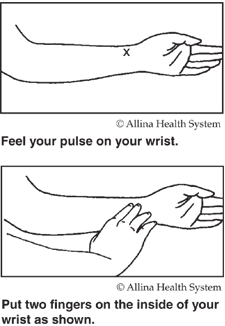
Target heart rate
The target heart rate is a guideline that can help you stay in a safe exercise heart rate range.
As your age increases, your target heart rate will decrease.
The target heart rate is based on 60 to 80 percent of a maximum heart rate.
- If you keep your heart rate in the lower range of the guideline, you will be able to exercise longer.
- If you keep your heart rate in the higher range of the guideline, you will have better cardio-respiratory fitness.
If you are just starting an exercise routine, you may want to start out at 60 to 70 percent of your target heart rate.
As you become more fit, you may want to progress to 70 to 80 percent of your target heart rate.
For example: If you are 30 years old and just started an exercise program, your target heart rate would be between 114 and 133 beats per minute, and 19 to 22 beats per 10 second count.
| Target heart rate maximum - Target training zones | |||||||
|---|---|---|---|---|---|---|---|
|
|
Approximate maximum heart rate |
Maximum target training zones (beats per minute) |
|||||
| Age | Heart rate | 60% | 65% | 70% | 75% | 80% | 85% |
| 20 | 200 | 120 | 130 | 140 | 150 | 160 | 170 |
| 25 | 195 | 117 | 127 | 137 | 146 | 156 | 166 |
| 30 | 190 | 114 | 124 | 133 | 143 | 152 | 162 |
| 35 | 185 | 111 | 120 | 130 | 139 | 148 | 157 |
| 40 | 180 | 108 | 117 | 126 | 135 | 144 | 153 |
| 45 | 175 | 105 | 114 | 123 | 131 | 140 | 149 |
| 50 | 170 | 102 | 111 | 119 | 128 | 136 | 145 |
| 55 | 165 | 99 | 107 | 116 | 124 | 132 | 140 |
| 60 | 160 | 96 | 104 | 112 | 120 | 128 | 136 |
| 65 | 155 | 93 | 101 | 109 | 116 | 124 | 132 |
| 70 | 150 | 90 | 98 | 105 | 113 | 120 | 128 |
| 75 | 145 | 87 | 94 | 102 | 109 | 116 | 123 |
| 80 | 140 | 84 | 91 | 98 | 105 | 112 | 119 |
It is important to exercise at a safe and effective training level. There are three ways to check that you are working at the right level for you.

Check your heart rate.
To do this:
-Find your pulse on your wrist. (See illustration.)
-Put two fingers on the inside of your wrist just below your thumb. (See illustration.)
-Press lightly until you feel your pulse.
-Count the heartbeats for 10 seconds. Multiply the heartbeats by six.
-If your pulse is irregular or skips beats, count the beats for a full 60 seconds.
-The average resting rate is between 60 to 100 beats each minute.
-If your rate is higher than average, slow down and don't exercise so hard.
Do the "talk test." This is your ability to have a fairly normal conversation while exercising. If you can sing, you need to work a little harder. If you have trouble talking, you need to slow down.